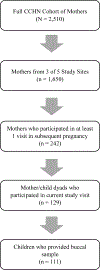Prenatal maternal stress prospectively relates to shorter child buccal cell telomere length
- PMID: 32927181
- PMCID: PMC9531598
- DOI: 10.1016/j.psyneuen.2020.104841
Prenatal maternal stress prospectively relates to shorter child buccal cell telomere length
Abstract
Prenatal exposure to stress increases risk for suboptimal child and adult mental and physical health outcomes, hypothesized to occur via fetal exposure to maternal stress hormones that alter growth and development. One proposed pathway through which stress exposure in utero could affect the offspring is by accelerating cellular aging in the form of telomere attrition. We tested this hypothesis in a cohort of 111 mother-child dyads, where mothers were assessed over 6 or more years, beginning prior to conception, and later during pregnancy, postpartum, and when the children were 3-5 years old. Adjusting for child age and concurrent maternal stress, we found that higher maternal perceived stress in the 3rd trimesters of pregnancy was predictive of shorter child buccal telomere length (bTL) (β = -0.24, p < .05), while maternal preconception and postpartum maternal stress were not associated with bTL (all p's > 0.42). These findings suggest a vulnerable time period in pregnancy when maternal stress influences offspring telomere length, suggesting the early embedding of adult disease might occur through biological aging pathways.
Keywords: Child outcomes; Maternal; Perceived stress; Pregnancy; Prenatal; Telomere length.
Copyright © 2020 Elsevier Ltd. All rights reserved.
Conflict of interest statement
Disclosures/Conflicts of Interest
All authors report no conflicts of interest.
Figures


Similar articles
-
Parental Preconception Posttraumatic Stress Symptoms and Maternal Prenatal Inflammation Prospectively Predict Shorter Telomere Length in Children.Psychosom Med. 2024 Jun 1;86(5):410-421. doi: 10.1097/PSY.0000000000001241. Epub 2023 Aug 21. Psychosom Med. 2024. PMID: 37594236 Free PMC article.
-
Prenatal stress and newborn telomere length.Am J Obstet Gynecol. 2016 Jul;215(1):94.e1-8. doi: 10.1016/j.ajog.2016.01.177. Epub 2016 Jan 30. Am J Obstet Gynecol. 2016. PMID: 26829506
-
Sex differences in effects of maternal risk and protective factors in childhood and pregnancy on newborn telomere length.Psychoneuroendocrinology. 2018 Sep;95:74-85. doi: 10.1016/j.psyneuen.2018.05.025. Epub 2018 May 17. Psychoneuroendocrinology. 2018. PMID: 29803183 Free PMC article.
-
Stress and telomere biology: a lifespan perspective.Psychoneuroendocrinology. 2013 Sep;38(9):1835-42. doi: 10.1016/j.psyneuen.2013.03.010. Epub 2013 Apr 29. Psychoneuroendocrinology. 2013. PMID: 23639252 Free PMC article. Review.
-
Exposure to different intrauterine environments: implications for telomere attrition in early life.J Matern Fetal Neonatal Med. 2019 Nov;32(21):3675-3684. doi: 10.1080/14767058.2018.1468879. Epub 2018 May 24. J Matern Fetal Neonatal Med. 2019. PMID: 29681194 Review.
Cited by
-
Prenatal stress and gestational epigenetic age: No evidence of associations based on a large prospective multi-cohort study.Res Sq [Preprint]. 2024 Jul 4:rs.3.rs-4257223. doi: 10.21203/rs.3.rs-4257223/v1. Res Sq. 2024. PMID: 39011115 Free PMC article. Preprint.
-
The interaction of socioeconomic stress and race on telomere length in children: A systematic review and meta-analysis.SSM Popul Health. 2023 Mar 22;22:101380. doi: 10.1016/j.ssmph.2023.101380. eCollection 2023 Jun. SSM Popul Health. 2023. PMID: 37065841 Free PMC article.
-
Intergenerational effects of maternal lifetime stressor exposure on offspring telomere length in Black and White women.Psychol Med. 2023 Oct;53(13):6171-6182. doi: 10.1017/S0033291722003397. Epub 2022 Dec 2. Psychol Med. 2023. PMID: 36457292 Free PMC article.
-
Major Stressful Life Events and the Risk of Pancreatic, Head and Neck Cancers: A Case-Control Study.Cancers (Basel). 2024 Jan 20;16(2):451. doi: 10.3390/cancers16020451. Cancers (Basel). 2024. PMID: 38275892 Free PMC article.
-
Protocol for the COVID-19 Wellbeing and Stress Study: a longitudinal study of parent distress, biological stress and child biopsychosocial development during the pandemic and beyond.BMJ Open. 2023 Aug 14;13(8):e071926. doi: 10.1136/bmjopen-2023-071926. BMJ Open. 2023. PMID: 37580092 Free PMC article.
References
-
- Barker DJP. In utero programming of chronic disease. Clin. Sci 1998; 95: 115–128. - PubMed

